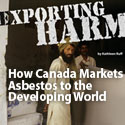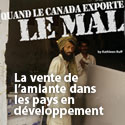Group of scientists and RightonCanada succeed in getting journal to retract the article
Kathleen Ruff, RightOnCanada.ca
In July 2016, two letters were submitted to the Journal of Occupational and Environmental Hygiene (JOEH) asking it to retract an article, Airborne asbestos exposures associated with the installation and removal of roofing products by Lotter et al. , with a statement that the article had been retracted on account of serious scientific and ethical improprieties.
On August 19, 2016, we were informed that the JOEH Board had voted to retract the article “due to an inadequate peer review stemming from the miscategorization of the article as a Case Study and not a Review article.”
The stated reason for retracting the article covers up the many serious improprieties that the JOEH was asked to address, namely – undisclosed conflict of interest on the part of the person who approved the article for publication, misrepresentation of data, distorted and misleading information, and erroneous conclusions that contribute to harming worker health.
The article, published online in June 2016, claimed that, for workers who installed and removed asbestos-containing roofing products, “the cumulative exposures associated with roofing work would be well below published chrysotile no-observed-adverse-effect-levels (NOAELs) for asbestos-related diseases.”
In a letter of July 22, 2016 to the JOEH, Perry Gottesfeld pointed out that the article falsely summarizes exposure data that it cites, provides misleading information and contradicts some of the key original research that it references. Gottesfeld called for the article to be retracted, noting that the article misrepresented key studies cited and grouped together different exposures to conclude that the installation and removal of these roofing products are “not expected to release appreciable amounts of airborne asbestos fibers.” Gotttesfeld was particularly concerned that the authors summarized data from projects involving asbestos-cement products with those that involved bituminous shingles and then relied on the manipulated data to draw erroneous conclusions.
In a second letter of July 28, 2016 , a group of scientists and health advocates called for the article to be retracted “because it is scientifically flawed; because it is contaminated by conflict of interest; and because its misinformation serves to cause harm to occupational and public health.”
The letter noted that the misinformation in the article is beneficial to the financial interests of the international asbestos industry which sells approximately two million tons of chrysotile asbestos every year. Most of this material is being used to manufacture asbestos-cement roofing in countries where workers cut, saw, hammer and break the roofing with very few, if any, occupational health protections. The scientific evidence is clear that workers carrying out these activities, as well as nearby children and adults, are exposed to harmful levels of asbestos fibres.
The International Chrysotile Association, the lobby organisation for the global asbestos industry, has been promoting the JOEH article on its website since June 2016 to assist the sale of asbestos-cement roofing in the global South and to reinforce the asbestos industry’s false claim that cutting and installing asbestos-cement roofing poses no threat to health.
The article was funded by the consulting company Cardno ChemRisk and written by four scientists employed by Cardno ChemRisk. The company and two of the four authors have extensive financial ties to asbestos interests. These conflicting interests were disclosed in the article.
For unexplained reasons, the article was improperly submitted to a Column Section of the journal, which is intended for commentary articles that do not undergo peer review. Thus the article was not peer reviewed and was apparently approved only by Charlie Blake, whose name is given above the article as “Case Study Column Editor.” In the information about its Editorial Board, provided by JOEH on its website, Blake is not among the ten people listed as the journal’s Column Editors nor is he identified as having any role on the editorial board.
Mr. Blake has extensive financial ties to asbestos interests and in the past four years has testified in 118 court cases on behalf of companies facing asbestos litigation. When questioned in court, Blake stated that over 50% and up to 70% of his consulting work over the past five years has been spent on such activities. Mr. Blake should have excluded himself from being in charge of the article because of his extreme financial conflicting interests. Not only did he fail to do so, he failed to even disclose his financial conflicting interests.
In their letter, the writers stated: “It is, in our opinion, particularly disturbing to see manipulation of scientific evidence when those involved in the writing, approval and publication of the misinformation have significant financial ties with the vested interests who benefit from its publication.”
The writers called on the JOEH to take five specific actions to address the failure of the journal to apply proper scientific and ethical standards, thus betraying the trust of its readers and contributing to harm to health of workers in countries where asbestos-cement roofing continues to be sold.
Instead, the JOEH Board of Directors has turned a blind eye to the scientific and ethical improprieties, taken misleading action with regard to the retraction of the article and responded with silence to the request that the JOEH implement specific policies to prevent this situation from re-occurring in future. This gives the impression that the JOEH Board of Directors wishes to cover up the scientific and ethical improprieties.
The JOEH has still not taken action to retract the article. This again indicates a lack of serious concern on its part to address gross scientific and ethical improprieties.
In a follow up message sent on August 19, the JOEH Board of Directors have been asked to act with transparency, clarity and integrity and take prompt action to:
- Retract the article with a statement that it has been retracted because of scientific and ethical improprieties.
- Respond to each of the requests for the JOEH to undertake specific policy changes to uphold ethical and scientific standards to ensure that the same misconduct is not repeated.
The JOEH is the official journal of the American Industrial Hygiene Association (AIHA). It is sad to see AIHA’s official journal publishing misinformation, serving the interests of the asbestos industry and contributing to harming the health of populations in the global South.
This is not only a betrayal of scientific evidence, it is also a betrayal of AIHA’s stated purpose to protect worker health.



One Response to “Journal will retract article denying harm from asbestos roofing”
Trackbacks/Pingbacks
[…] a few months after publication, an environmental journal has told an activist group it plans to retract a paper about the safety of roofing products containing asbestos after facing […]